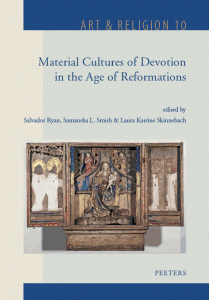New Book by Éric Palazzo: Broder la Splendeur (Paris 2024), an exegesis of Christian ornaments

Comment le christianisme s’est-il approprié le thème de l’ornement issu de la culture romaine ? Comment a-t-il fait de cette notion l’un des piliers de sa théologie ? Comment la liturgie et l’art ont-ils été pensés comme les deux vecteurs essentiels de la beauté de Dieu et de son oeuvre de création ? C’est en expert du Moyen Âge qu’Éric Palazzo explore à nouveaux frais le thème de l’ornement dans le christianisme antique et médiéval ainsi que ses déclinaisons dans les domaines artistique et liturgique. À travers, entre autres, les grandes figures que furent Cassiodore dans l’Antiquité et Théodulf à l’époque carolingienne, et l’analyse de nombreux décors peints, mosaïques ou enluminures, Éric Palazzo nous offre une initiation essentielle et inédite à la théologie de la beauté. Une magnifique exégèse de l’ornement.
ENID-Jubilee on Relics and Reliquaries in Rome, 11-13 October 2023
On 11-13 October, 2023, ENID marked its twentieth anniversary with an international seminar entitled Relics and Reliquaries – Seeing is Believing, that was held at The Norwegian Institute in Rome (DNIR). The focus was on Medieval and Early Modern Western Christianity, but without losing sight of later, and even contemporary developments. The first day was filled with eight lectures, held by ENID members Henning Laugerud, Justin Kroesen (with Aintzane Erkizia from the University of the Basque Country, Spain), Malgorzata d’Aughton, and Rob Faesen, DNIR director Kristin Bliksrud Aavitsland and Marianne Ritsema van Eck, postdoc at the same institution, and invited speakers Cynthia Hahn (Hunter College, New York) and David Morgan (Duke University). Research questions included: What media and strategies were chosen by commissioners and craftsmen to express and substantiate the authenticity of the relic that was kept inside? What shapes, materials, images etc. were employed to convey the idea that the contents were real and sacred, in other words: what is the relationship between the in- and outside of reliquaries? And how was their credibility enhanced by spatial settings, ritual practices and written documents? What is the relationship between text, such as inscriptions, and image in the forging of this credibility? How did the power of relics animate images and devotional objects into which they were inserted? And what is the added value of relic collections, does this create a “condensed sanctity”? On the second day, an excursion led to several Roman sites, including the Basilica of Santa Croce in Gerusalemme and Santa Maria Antiqua at the Forum Romanum, and on the third day, the medieval abbey of Grottaferrata was visited.
Iconographisk Post >
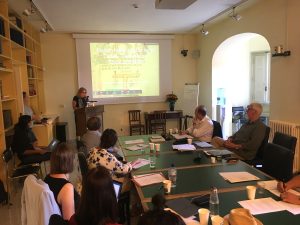 Cynthia Hahn presenting in the auditorium of the Norwegian Institute in Rome
New book:
Image as life: animism revived in wonders of vivification
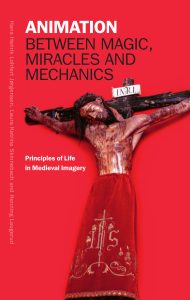
When it comes to images, we are all animists. This still applies today, when the image is as alive as ever. So, we need to study historical cultures of animation to get a deeper sense of living imagery, past and present.
“Animation” does indeed imply that an ensouled image or empowered object is alive, endowed with anima: a “soul”, “spirit” or “vital principle.” In the Middle Ages, holy (or emphatically unholy) imagery often possessed a treasured (or dreaded) ability to come to life, to act and do things, to move and gesticulate, to speak and exude.
This animist book is about the different modes and principles of animation that made medieval images perform their spectacular wonders of locomotion and physical transformation. It ranges from mechanical machinery to works of magic and motor miracles. We engage with talking and bleeding crucifixes; we listen to ventriloquized oracles, moving Madonnas, robot Redeemers and automated devils. Such self-propelled movers enacted their natural or supernatural animations in monasteries and churches, in demonic technologies and occult treatises, in marvels of magic, miracles and mechanics.
With its return to medieval animism, this book will enliven anyone with an interest in the agency of images, medieval art and art history, body and spirit, material culture and ideas, anthropology and religion, theology and philosophy.
ANIMATION BETWEEN MAGIC, MIRACLES AND MECHANICS
By Hans Henrik Lohfert Jørgensen, Laura Katrine Skinnebach and Henning Laugerud
ISBN 978 87 7219 653 4
295 PAGES
349,95 DKK
RELEASE DATE: August 18 2023
CONTACT THE AUTHORS
Hans Henrik Lohfert Jørgensen hh@cc.au.dk
+ 45 87 16 30 52
Laura Katrine Skinnebach
lks@cc.au.dk
Henning Laugerud
henning.laugerud@uib.no
+00 47 55 58 42 28
CONTACT THE PUBLISHER unipress@unipress.au.dk
Phone +45 53 55 05 42
Aarhus University Press Helsingforsgade 25 8200 Aarhus N, Denmark tlf. + 45 53 55 05 42 unipress.dk
New Edited volume by Barbara Baert (a. o.)
‘Ornamenta Sacra’. Late Medieval and Early Modern Liturgical Objects in a European Context
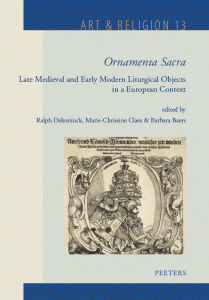
Editors: Ralph Deconinck, Marie-Christine Claes, Barbara Baert
Series: Art & Religion, 13
Summary: This volume is dedicated to the study of late medieval and early modern liturgical objects, once known as ornamenta sacra. It encompasses a wide range of objects made of various materials and techniques which are not only essential for the rites, but also hold a central position in the religious and artistic production of the past. The contributions to this volume understand them at the heart of a system of complex relationships which make them contribute to their religious functions, but also to their aesthetic, symbolic and social ones: relationships with the men who commissioned, produced and manipulated them, but also with liturgical time and space; relationships too between these different objects, as also with the prescriptive and spiritual frameworks which dictate or accompany their uses. It is the life of these objects that is here recounted, objects invested with value at one and the same time religious, financial and aesthetic.
To order, follow this link: https://www.peeters-leuven.be/detail.php?search_key=9789042948280&series_number_str=13&lang=en
NEW ENID VOLUME PUBLISHED AND LAUNCHED!
At the ENID meeting in Rome, on Tuesday 8 May 2022, the latest ENID volume was presented at the Norwegian Institute in Rome: Salvador Ryan, Samantha L. Smith and Laura K. Skinnebach (eds), Material Cultures of Devotion in the Age of Reformations (=Art and Religion, 10), Louvain etc.: Peeters, 2022.
Summary: The sixteenth and seventeenth centuries in Northern Europe were characterized by enormous religious change. During this period new religious ideas and ideals gradually took shape and materialized in all aspect of religious life, both on a private level as well as in public and liturgical space. The fundamental question of how God could be experienced as present in the world, became – again – the center of lively debate. Lutheran, Calvinist, Roman Catholic and Anglican reformations – to mention just a selection of the different ideological movements in play during this period – challenged interpretations of the Bible, the sacraments, the communication of religious truth, the practice of devotion and the material expressions of faith. When looking at the European reformations from a transnational perspective, they stand forth as a bundle of fundamentally interwoven religious movements attempting to define their specific religious identity in terms of dissimilarity. Material Cultures of Devotion in the Age of Reformations explores how the visual and material cultures of Christian devotion were adapted, developed, transformed, and, in some cases, disappeared altogether, in the age of reformations, c. 1500-1650 in Northern Europe.
New Book by Barbara Baert, Looking Into The Rain. Magic, Moisture, Medium, Berlin/Boston: De Gruyter, 2022 (235 pp.)
Humankind has traditionally had a special relationship with the atmospheric characteristics of their environment, especially when it comes to rain. Using unique and expertly developed cases – from prehistoric cave paintings up to the meaning of rain in photography and cinema – this book casts new light on a theme that is both ecological and iconological, both natural and cultural-historical. Are our current paradigms in the visual studies enough to be able to describe the art and culture surrounding rain in a nuanced way, even to reach Beyond? Considering one does not simply look at the rain, one looks into the rain? Its effect on the audience is contaminating, it seeps through, elusive and dynamic. In the book, important cultural thinkers from both the past as well as the present are invited to carefully consider these questions with the author. Barbara Baert’s touching essay reveals the capability of humans to combine imagery and fascination into one. Baert’s unique prose makes Looking Beyond the Rain. Magic-Moisture-Medium a profound, bold, and sometimes fervent essay.
Barbara Baert is Professor of Art History at KU Leuven. She teaches in the field of Iconology, Art Theory & Analysis, and Medieval Art. Her work links knowledge and questions from the history of ideas, cultural anthropology and philosophy, and shows great sensitivity to cultural archetypes and their symptoms in the visual arts.
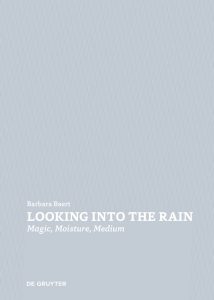
NEW CATALOGUE ON THE BERGEN MEDIEVAL CHURCH ART COLLECTION
On 25 January 2022, the new catalogue on the Medieval church art collection at the University Museum of Bergen was launched. The catalogue was written by ENID members Justin Kroesen and Stephan Kuhn, while ENID founder Henrik von Achen wrote an introductory chapter on the collection’s history. Alf Tore Hommedal wrote an additional introductory chapter on the church landscape of western Norway in the Middle Ages. The book was published by Schnell und Steiner Verlag in Regensburg, Germany, and is available in three parallel language versions (English, German, Norwegian). It costs 25 euros and can be ordered via: https://www.schnell-und-steiner.de/artikel_10393.ahtml
The collection of medieval church art at the University Museum of Bergen is among the finest of its kind in Europe. Most of the objects have come from churches in western Norway, but their materials, techniques, styles and iconography reflect the many cultural connections that linked this remote region not only with the lands surrounding the North Sea, but to the Mediterranean and beyond. Most outstanding are high medieval altar decorations of painted wood: twenty altar frontals, various polychromed sculptures and a vaulted altar canopy. The collection also includes Romanesque baptismal fonts, late Gothic winged altarpieces, and liturgical vessels and vestments. Introductory chapters on the museum’s 200-year history and on western Norway’s medieval church landscape are followed by a presentation of one hundred selected art works.
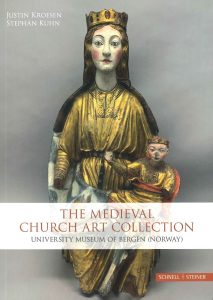
NEW BOOK BY BARBARA BAERT: THE GAZE FROM ABOVE (ART & RELIGION, 11)
When gazing into the vast expanse of ‘the universe’, humankind experiences the universal desire to fathom the mystery of its creation. We utilize our unique ability to express ourselves through artistic means to make this mystery tangible, transmuting the secrets of the cosmos into stunning objects and ingenious symbols. Through a deep engagement with recent iconological methods the author travels up and down a methodological Jacob’s ladder, between the artist’s gazes from the earth to the sky. The reader is treated to studies on a wide variety of objects and mediums, ranging from the embroidery of Girona, the Hereford mappa mundi to the genesis cycle in the Saint Mark’s Basilica in Venice. The author reconsiders the iconic gaze of van Eyck’s lamb and enters Danaë’s uncanny, voyeuristic space in the painting by Jan Gossaert. Meanwhile, she allows other thinkers to explore these questions alongside her. She turns to Erwin Panofsky, who writes about his fascination with Galileo Galilei’s telescope, and finally Lars von Trier and his movie Melancholia gets to call it Schluss. All the artworks in this captivating book contribute to unravel the largest mystery that surrounds us: the cosmos. The image blooms into the countenance of that majestic, astonishing black pupil above us. Or as Aby Warburg once wrote: “Contemplation of the sky is the grace and the curse of humanity.”
Barbara Baert, The Gaze from Above. Reflections on Cosmic Eyes in Visual Culture (=Art & Religion, 11), Louvain: Peeters, 2021
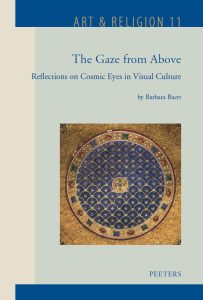
ENID member Justin Kroesen is the Prado Chair 2021
Justin Kroesen (Bergen) is the ninth scholar to occupy the Prado Chair founded by the Escuela del Prado at the Museo del Prado in Madrid, Spain. This year’s edition centres on medieval art, both in the collections of the Prado itself and elsewhere in Spain and in Europe. The programme carries the title: Medieval Art: Encounters Between Museums and Churches. The kick-off took place on 1 October 2021 with a one-day symposium on Las artes del altar (‘the Arts of the Altar’), with an opening lecture by the Chair and four invited lectures by specialists in the field on the development of medieval altar decorations in Spain. The programme includes four public lectures and four seminars for a group of selected early-career researchers. The full programme is accessible through the website of the museum (in Spanish): https://www.museodelprado.es/recurso/arte-medieval-encuentros-entre-museos-e-iglesias/681b0882-5e93-46f7-0de1-79a205956ced The titles of the lectures are (translated): 4 November 2021 – Museums and Churches, two Goldmines for the History of Medieval Art; 11 November 2021 – The Artistic Explosion in Thirteenth-Century Europe Between North and South; 18 November 2021 – Medieval Altarpieces in the Iberian Peninsula in Europe’s Artistic Landscape; 25 November 2021 – The Altarpiece in the Medieval Church Interior
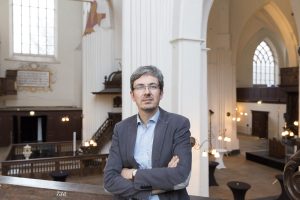
Justin Kroesen (photo Sjaak Verboom)
Jacolien Wubs defended her PhD thesis on The Visuality of Texts in Calvinist Churches in the Dutch Republic
On 14 October 2021, ENID member Jacolien Wubs successfully defended her PhD thesis To Proclaim, to Instruct and to Discipline. The Visuality of Texts in Calvinist Churches in the Dutch Republic at the University of Groningen (the Netherlands). This project was supervised by Prof. Raingard Esser (Groningen) and ENID member Justin Kroesen (Bergen). ENID member Prof. Henning Laugerud (Bergen) was a member of the evaluation committee.
The traditional image of the Dutch church interior is that of a whitewashed, serene space: the strong emphasis on the Word after the Reformation resulted in the thorough removal of imagery from the formerly Catholic churches. However, this study of text panels and text paintings in Dutch Calvinist church interiors in the late sixteenth and seventeenth centuries shows that the Word did not completely rule out the visual in Reformed church interiors. In fact, the Word itself was turned into an image, and text decoration became a means in the adaptation of churches for Reformed use.
This study by Jacolien Wubs provides an overview of the variety of texts placed in churches after the Reformation, ranging from everyday house rules to Bible texts about the Lord’s Supper, as the most important sacrament of the Reformed church. It shows how text panels and text paintings served as an alternative to and sometimes as a literal replacement of removed Catholic images. Placed at sites in the church that were particularly important in Reformed liturgy, texts proclaimed Reformed faith and underlined the break with the Catholic past of the church. This research adds nuance to the narrative of change that surrounds the Reformation by pointing to continuity, in the texts, in the visual motifs and in the spatial setting of text decoration in churches.
The thesis includes a comparison of forms of text decoration in churches of different protestant denominations around the North Sea, including England and Norway (Jacolien Wubs spent a semester as a guest researchjer at the University Museum of Bergen in 2018).
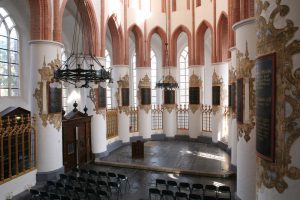
Texts decorate the columns in the Der Aa-church in Groningen, the Netherlands (photo Regnerus Steensma archive)
CALL FOR PAPERS
Our member Salvador Ryan is currently guest-editing a special issue of the journal Religions, on Representations and Interpretations of the Passion and Death of Christ: Global Perspectives». Please follow this link for all relevant details: https://www.mdpi.com/journal/religions/special_issues/passion_death_Christ Readers may also be interested in some of the articles that were published in the last special issue, on Material Religion, Popular Belief and Catholic Devotional Practice in the Age of Vatican II (c. 1948-c. 1998): Global Perpectives, which is now available online: https://www.mdpi.com/journal/religions/special_issues/mrpb
NEW BOOK
«Northern European Reformations»
James E. Kelly, Henning Laugerud, Salvador Ryan (eds.), Northern European Reformations. Transnational Perspectives. Palgrave MacMillanThis book examines the experiences and interconnections of the Reformations, principally in Denmark-Norway and Britain and Ireland (but with an eye to the broader Scandinavian landscape as well) and discusses instances of similarities between the Reformations in both realms. The volume features a comprehensive introduction and provides a broad survey of the beginnings and progress of the Catholic and Protestant Reformations in Northern Europe, while also highlighting themes of comparison that are common to all of the bloc under consideration, which will be of interest to Reformation scholars across this geographical region.

Read more here >
CONFERENCE
Upcoming conference in Poland September this year:
WHAT DOES ANIMATION MEAN IN THE MIDDLE AGES?
Theoretical and Historical Approaches
International Conference in Bialystok, Poland, 16–19 September, 2021
This conference is concerned with the agency and life of material objects and evolves around the investigation of two interlaced objectives. First, the conference will shed light on understudied aspects of medieval visual culture, focusing in particular on the agency of images and material objects. Second, it will provide new cutting-edge theoretical reflections and methodologies con-cerning the study of material agency and “living images” today. We argue that the cultural use of and interaction with images may be regarded as more than mere historically or culturally specific phenomena. Rather, it concerns the ontology of images and constitutes a fundamental aspect of our life with images, in the premodern as well as in the contemporary. It is our contention that images are embedded in social interaction and that animation is deeply constitutive of the production of meaning. Animation, we argue, is not only located in the mind of the beholder, but in the epistemology, creation, interaction and materiality of images. Furthermore, we will argue that medieval animation may inform contemporary views on animation and provide us with a more precise vocabulary to capture current phenomena for instance in the digital world. The conference aim to be interdisciplinary and transhistorical in its perspective and targets scholars of visual studies, material studies, study of religions, anthropology, medieval studies and theology. It is also relevant more generally for current discussions about the life and agency of seemingly dead matter.
Please read more here >>>
CFP – Animation in the Middle Ages – 2021
|





